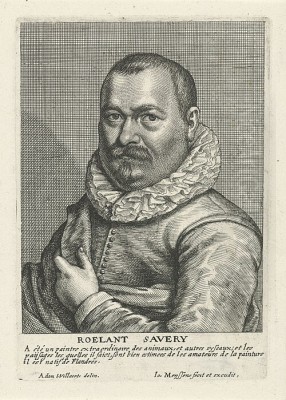
Roelandt Savery stands as a fascinating figure in the art history of the late sixteenth and early seventeenth centuries. Born into the rich artistic traditions of Flanders, his life and career were shaped by religious upheaval, prestigious court patronage, and the burgeoning artistic scene of the Dutch Republic. Active just before the full blossoming of the Dutch Golden Age, Savery carved a unique niche for himself, excelling in detailed landscapes, pioneering animal paintings filled with exotic creatures, and contributing significantly to the early development of flower still life. His work forms a bridge between the lingering influences of Mannerism and the emerging naturalism that would define the era, making him a pivotal, if sometimes overlooked, artist.
Early Life and Flemish Roots
Roelandt Savery was born in Kortrijk (Courtrai), West Flanders, around 1576. His family belonged to the Anabaptist minority, a Protestant group facing persecution in the Spanish-controlled Southern Netherlands. This religious pressure, combined with the turmoil of the Eighty Years' War, forced the Savery family, like many other skilled artisans and intellectuals, to seek refuge in the more tolerant Northern Netherlands. They initially moved around 1580, possibly first to Haarlem, a city already establishing itself as an artistic center, before settling in Amsterdam.
Crucially, Roelandt received his initial artistic training from his older brother, Jacob Savery (c. 1566–1603). Jacob was already a successful artist, known for his landscapes, animal depictions, and still lifes, working in a style influenced by the Flemish tradition. Jacob himself had been a pupil of Hans Bol (1534–1593), a significant Flemish painter and draughtsman known for his miniature landscapes and genre scenes. This artistic lineage grounded Roelandt firmly in the detailed, observational style characteristic of Flemish painting, particularly the landscape tradition pioneered by artists like Joachim Patinir and Pieter Bruegel the Elder.
Jacob Savery's influence on his younger brother was profound, likely instilling in Roelandt a love for depicting the natural world, both flora and fauna, alongside landscape settings. Jacob's own premature death from the plague in Amsterdam in 1603 meant Roelandt had to establish his independent career relatively early.
The Prague Years: Service to Emperor Rudolf II
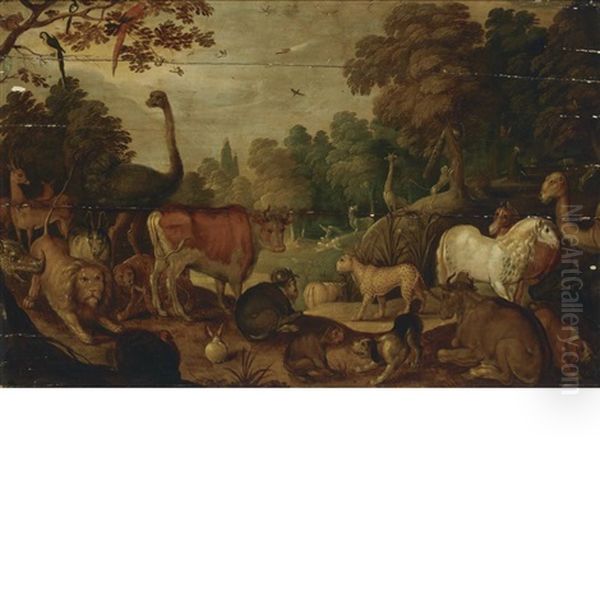
A defining period in Savery's career began around 1604 (though he may have travelled earlier) when he entered the service of the Holy Roman Emperor Rudolf II in Prague. Rudolf's court was one of the most intellectually and artistically vibrant centers in Europe, a hub for artists, scientists, alchemists, and thinkers from across the continent. The Emperor was an avid collector, amassing a vast Kunstkammer (cabinet of curiosities) filled with natural wonders, scientific instruments, and artworks. He also maintained an extensive menagerie with exotic animals.
Savery served as a court painter (Kammermaler) to Rudolf II until the Emperor's death in 1612. This position provided him with unparalleled opportunities. He had access to Rudolf's collections and zoo, allowing him to study and sketch exotic creatures like lions, tigers, camels, ostriches, pelicans, and, most famously, the dodo – a flightless bird from Mauritius that would soon become extinct. Savery became one of the few artists to depict the dodo, likely based on specimens (perhaps stuffed or even live) in the imperial collection.
During his time in Prague, Savery also undertook sketching trips, notably to the Tyrol region of the Alps between 1606 and 1608. These journeys allowed him to study mountainous landscapes firsthand, resulting in drawings and paintings that captured the dramatic rock formations, waterfalls, and rugged terrain with a new level of realism, which he would incorporate into his works for years to come.
At the imperial court, Savery interacted with other prominent artists working in the sophisticated, international style often termed Northern Mannerism. These included Bartholomeus Spranger (1546–1611), Hans van Aachen (1552–1615), and the landscapist Pieter Stevens (c. 1567–after 1624). He also likely knew the renowned engraver Aegidius Sadeler II, who reproduced some of Savery's designs. Exposure to this milieu undoubtedly refined Savery's technique and perhaps encouraged the slightly fantastical or stylized elements sometimes present in his work, blending Flemish detail with Mannerist elegance.
Artistic Style: Flemish Detail and Mannerist Flourishes
Roelandt Savery's style is characterized by meticulous detail, a high degree of finish, and a vibrant color palette. His grounding in the Flemish tradition is evident in his precise rendering of textures, foliage, and animal anatomy. He often worked on copper or wood panels, surfaces that allowed for smooth application of paint and the depiction of minute details. His landscapes frequently follow the established Flemish convention of a high viewpoint, with detailed foregrounds, receding middle grounds, and atmospheric, often blue-tinted, distant vistas.
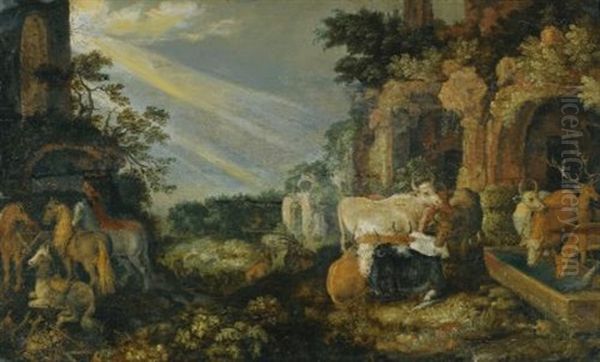
His connection to the Prague court and exposure to Mannerism added another layer to his art. While not fully embracing the elongated figures or complex allegories typical of Spranger, Savery's compositions can be dense and crowded, particularly his famous Paradise scenes teeming with animals. There's often a decorative quality, a delight in rendering the exotic and the unusual, that aligns with the tastes of the Rudolfine court. His depiction of rocky landscapes, sometimes contorted into fantastical shapes, also echoes Mannerist tendencies.
Compared to his near-contemporary, the Flemish master Jan Brueghel the Elder (1568–1625), often called 'Velvet' Brueghel for his smooth finish, Savery's work can appear slightly more archaic or wild. Both artists shared an encyclopedic interest in the natural world and a penchant for detail, often collaborating with figure painters. However, Savery's landscapes often possess a greater sense of untamed nature, and his animal depictions, while detailed, sometimes carry a stronger element of stylization compared to Brueghel's more consistently naturalistic approach.
Master of Flora and Fauna
Savery's reputation rests significantly on his depictions of animals and plants. His time in Prague, with access to Rudolf II's menagerie, was crucial. He produced numerous studies and finished paintings featuring a wide array of creatures, often shown coexisting peacefully in lush landscapes, particularly in his popular Garden of Eden or Orpheus Charming the Animals themes. These works showcased not only his observational skill but also his imaginative ability to combine diverse species within a single composition.
His paintings of the dodo are particularly noteworthy. As the bird became extinct by the late 17th century, Savery's depictions, created decades earlier, are among the most important visual records we have. He included the dodo in several paintings, suggesting a particular fascination with this unusual creature, perhaps reflecting the Emperor's own interest in natural rarities.
Beyond the exotic, Savery also meticulously depicted common European animals, birds, insects, and reptiles, often incorporating them into his landscapes and still lifes. His keen eye for detail extended to the botanical world. Savery was one of the pioneers of the independent floral still life in the Netherlands. Emerging around the turn of the 17th century, this genre catered to a growing interest in botany and the appreciation of rare and beautiful flowers.
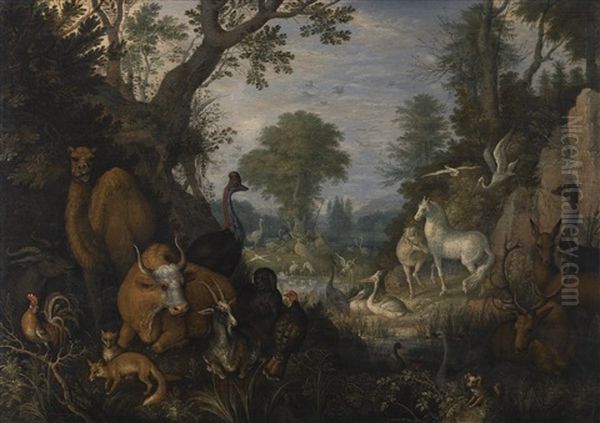
Savery's flower paintings, often dated to his later Utrecht period, typically feature a diverse bouquet of flowers from different seasons arranged in a glass or vase. These works are characterized by their precise rendering, vibrant colors, and often include small insects or lizards among the blooms. The level of detail is such that botanists can often identify the specific species depicted. These paintings likely carried symbolic meanings related to the beauty and transience of life (vanitas), themes common in Dutch still life. He was working in this genre concurrently with other pioneers like Ambrosius Bosschaert the Elder (1573–1621), who became a friend in Utrecht.
Landscapes: Alpine Vistas and Mythical Realms
Landscape painting was central to Savery's output throughout his career. His early works show the influence of his brother Jacob and the broader Flemish tradition, particularly artists like Gillis van Coninxloo III (1544–1607), another Flemish émigré known for his influential forest landscapes, whom Savery may have encountered. Savery's forest scenes are often dense and intricate, filled with carefully rendered trees, foliage, and often small figures or animals that animate the scene.
His travels in the Alps provided inspiration for a distinct type of landscape featuring dramatic, rocky mountains, cascading waterfalls, and rustic bridges or cottages. These works, based on his Tyrolean sketches, brought a sense of grandeur and wildness to Dutch landscape painting, influencing later artists. He often used strong contrasts of light and shadow to enhance the dramatic effect, bathing parts of the scene in bright sunlight while plunging others into deep shade.
Savery frequently populated his landscapes with mythological or biblical narratives. The theme of Orpheus Charming the Animals was a favorite, allowing him to combine his skills in landscape and animal painting. His Garden of Eden or Paradise landscapes were similarly popular, depicting the harmony of creation before the Fall, filled with an astonishing variety of creatures rendered with his characteristic detail. These compositions, while rooted in observation, often possess a fantastical quality, creating idealized visions of nature.
Return to the Netherlands and the Utrecht Years
After the death of Rudolf II in 1612 and a brief period serving his successor Emperor Matthias, Savery left Prague. He seems to have spent time back in Amsterdam and possibly Haarlem before finally settling in Utrecht around 1619. Utrecht was a major artistic center, distinct in some ways from Amsterdam or Haarlem. It was notably home to the "Utrecht Caravaggisti," painters like Gerard van Honthorst (1592–1656), Hendrick ter Brugghen (1588–1629), and Dirck van Baburen (c. 1595–1624), who had absorbed the dramatic chiaroscuro and realism of Caravaggio in Rome.
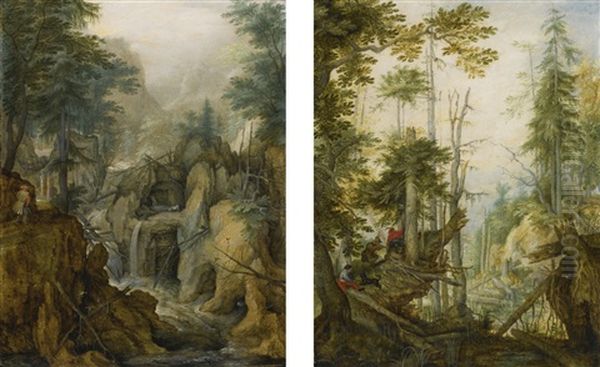
While Savery's detailed, colorful, and often Mannerist-inflected style differed significantly from the Caravaggisti, he became a respected member of the Utrecht artistic community. He joined the city's Guild of Saint Luke, the professional organization for painters. He established a successful workshop and attracted students. His house and garden reportedly became something of a meeting place for fellow artists, including flower painters like Ambrosius Bosschaert the Elder and his brother-in-law Balthasar van der Ast (1593/94–1657), with whom Savery shared a close friendship and mutual artistic interests, particularly in still life. The painter William Adamers was also noted as a visitor.
During his Utrecht period, Savery continued to produce the landscapes, animal paintings, and flower still lifes that had become his specialty, often revisiting themes and compositions developed during his Prague years but perhaps with an increasing emphasis on Dutch naturalism in some works. His paintings remained popular with collectors both in the Netherlands and abroad.
Students and Influence
Roelandt Savery was an influential teacher. Several artists who studied with him went on to have successful careers, carrying forward aspects of his style and subject matter. Among his most notable pupils were:
Allart van Everdingen (1621–1675): Known primarily for his dramatic Scandinavian landscapes featuring waterfalls and pine forests, Van Everdingen may have been inspired by the wildness and ruggedness found in Savery's Alpine scenes.
Willem van Nieuwlandt II (1584–1635/36): Although older, sources suggest he studied with Savery. He became known for his Italianate landscapes, often featuring ruins, but also painted some animal subjects.
Gillis d'Hondecoeter (c. 1575–1638): Another Flemish émigré, d'Hondecoeter specialized in landscapes with prominent depictions of birds and animals, clearly influenced by Savery. He was the father of the even more famous bird painter Melchior d'Hondecoeter.
Savery's influence extended beyond his direct pupils. His detailed depictions of animals set a standard and likely influenced later Dutch animal specialists like Paulus Potter (1625–1654), although Potter adopted a more purely naturalistic style typical of the high Golden Age. His landscapes contributed to the diversity of the genre in the Netherlands, and his flower still lifes were important early examples that influenced painters like his friend Balthasar van der Ast. There is even an anecdote suggesting that the great Flemish portraitist Anthony van Dyck (1599–1641) admired and drew one of the exotic lizards featured in a Savery painting. His work may also have had some resonance with Utrecht painters like Jacob Gerritsz. Cuyp (1594–1652) who also incorporated animals into landscapes.
Later Life and Legacy
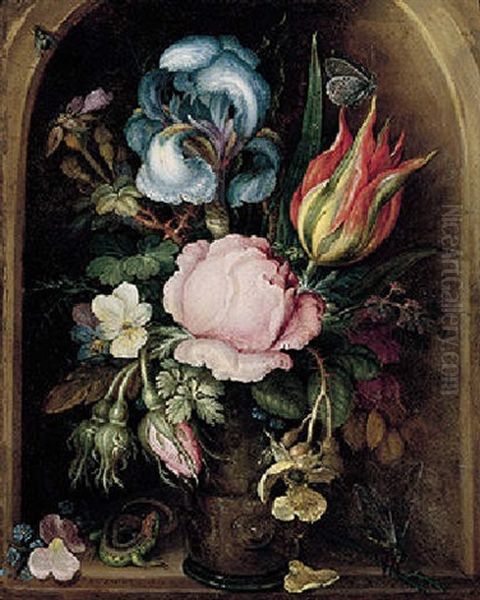
Despite his success and reputation, Roelandt Savery's later years were marked by difficulty. Records indicate that he faced financial problems, leading to bankruptcy proceedings around 1638, shortly before his death. Some accounts suggest possible mental instability in his final years, though this is hard to confirm definitively. He died in Utrecht in February 1639 and was buried there.
Roelandt Savery's legacy lies in his unique position bridging different artistic traditions and periods. He brought a Flemish sensibility for detail and landscape to the international Mannerist court of Prague, absorbing its sophistication and taste for the exotic. Returning to the Netherlands, he contributed significantly to the genres that would define the Golden Age, particularly animal painting and flower still life, while retaining elements of his earlier style.
He was a master observer of the natural world, yet capable of creating fantastical and idealized visions. His paintings of exotic animals, especially the dodo, remain iconic. His Alpine landscapes introduced a new type of dramatic scenery to Dutch art. His flower pieces stand among the earliest and most beautiful examples of the genre. Though perhaps overshadowed by later Golden Age masters, Savery's distinctive style, diverse subject matter, and historical position make him a crucial figure for understanding the complex artistic landscape of the early seventeenth century.
Major Works and Where to See Them
Roelandt Savery was prolific, and his works are held in major museums across the world. Some of his key paintings and representative locations include:
The Garden of Eden / Paradise Landscapes: Multiple versions exist, showcasing his skill in depicting numerous animals harmoniously. Examples can be found in the Gemäldegalerie Alte Meister (Dresden), the National Gallery (London), and other collections.
Orpheus Charming the Animals: Another popular theme combining landscape, mythology, and animal painting. Examples are in the Mauritshuis (The Hague) and the National Gallery (London).
Alpine Landscapes: Based on his Tyrolean sketches, featuring dramatic mountains and waterfalls. Examples can be found in the Centraal Museum (Utrecht) and the Rijksmuseum (Amsterdam). A notable example is held at the Thyssen-Bornemisza Museum (Madrid).
Flower Still Lifes: Exquisite examples of his pioneering work in this genre. A famous piece is in the Centraal Museum (Utrecht), and another important one is at the Mauritshuis (The Hague).
Paintings featuring the Dodo: These historically significant works are highly prized. One is in the Natural History Museum (London, on loan from the Ashmolean Museum, Oxford), and others are integrated into his Paradise scenes held by various museums.

Studies of Animals and Plants: Numerous detailed drawings and oil sketches exist, held in print rooms and museum collections worldwide, including the British Museum (London) and the Getty Museum (Los Angeles).
Other significant holdings of Savery's work can be found at the Wallraf-Richartz Museum (Cologne), the Hermitage Museum (St. Petersburg), the Musée des Beaux-Arts (Brussels), the National Gallery of Canada (Ottawa), and the National Gallery (Prague).
Conclusion
Roelandt Savery occupies a unique and important place in European art history. A product of the Flemish diaspora, refined in the crucible of Rudolf II's Prague court, and a respected master in Utrecht, his career traversed geographical and stylistic boundaries. He masterfully blended meticulous Northern European realism with elements of Mannerist fantasy and elegance. As a pioneer in the depiction of exotic animals, a key early figure in the development of floral still life, and a creator of dramatic landscapes, Savery left an indelible mark. His work offers a fascinating window into the artistic tastes, scientific curiosity, and cultural exchanges of the late sixteenth and early seventeenth centuries, securing his position as a significant contributor to the foundations of the Dutch Golden Age.